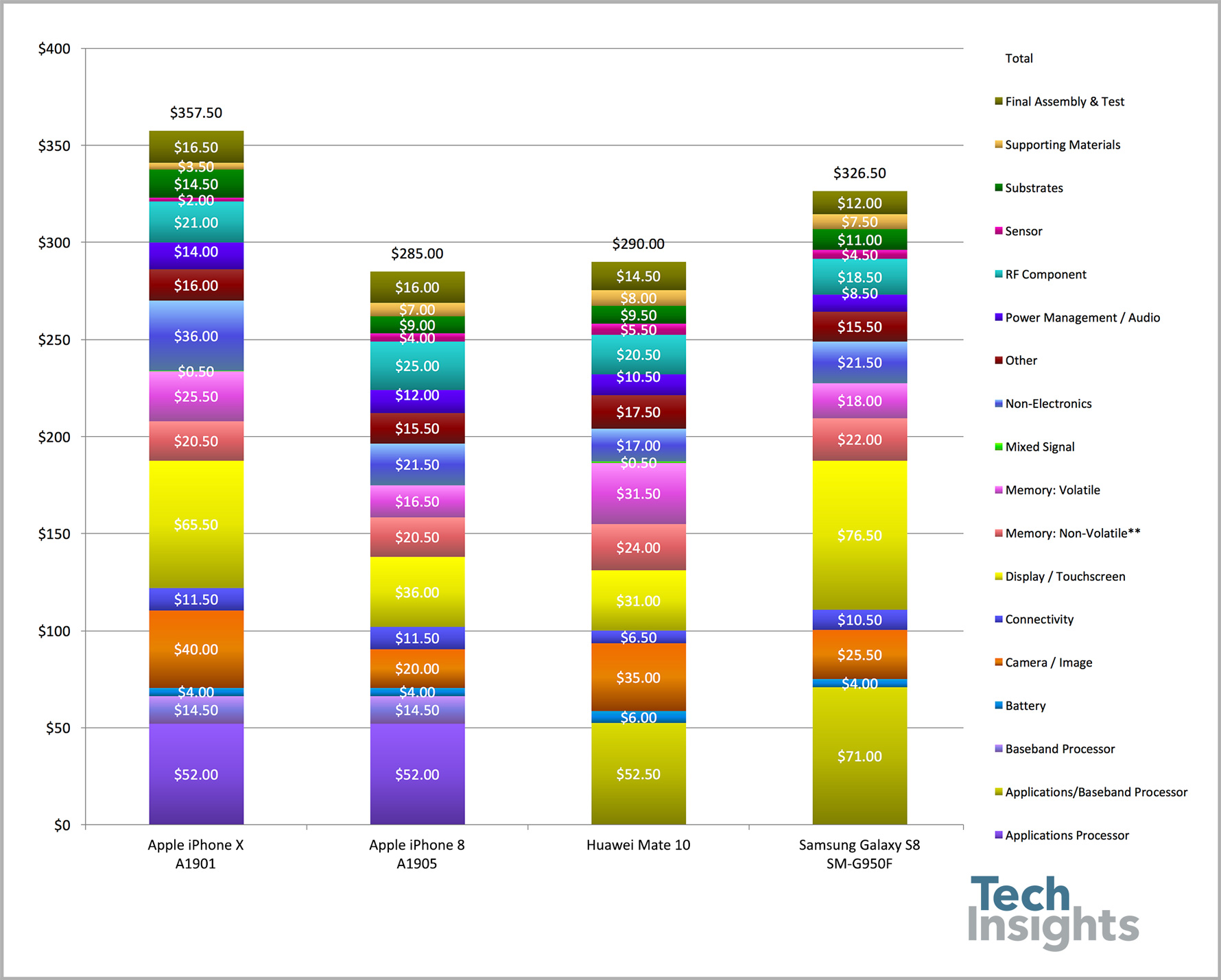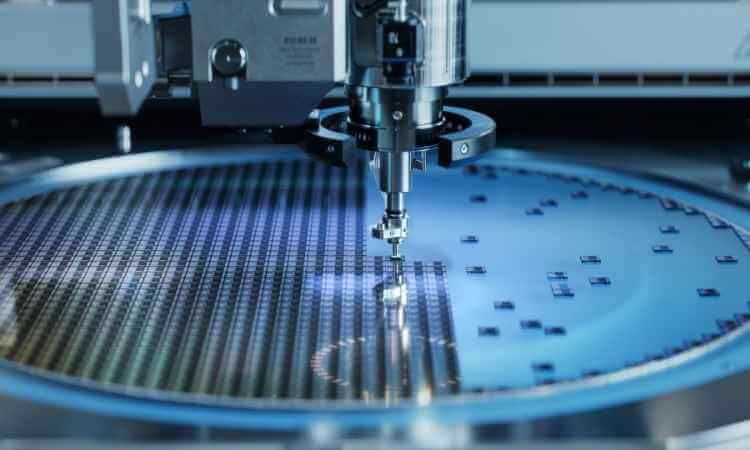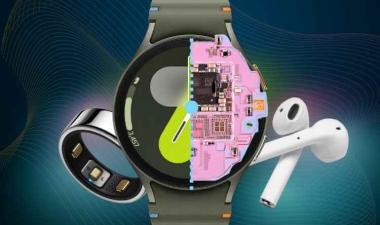Posted: November 10, 2017, Updated: November 15, 2017
Contributing Authors: Al Cowsky, Stacy Wegner
While Apple and Samsung have been engaged in a tug-of-war for the title of top-selling smartphone provider over the past couple of years, China’s dominant OEM – Huawei – has been quietly gaining traction globally with their P- and Mate-series offerings.
Recently, TechInsights published a piece in which we compared the component costs of the Apple iPhone 8, the Huawei Mate 10, and the Samsung Galaxy S8. Even more recently, we have kicked off our teardown of the Apple iPhone X. This article provides a cost comparison of all four phones:
Our reports provide our complete details of each phone, and our various tools provide a number of ways to slice and dice and compare data about them; here, we are providing a summary cost comparison of the four phones.

Cost Comparison Observations
| Category | Apple iPhone X A1901 |
Apple iPhone 8 A1905 |
Huawei Mate 10 (Quick Turn Teardown) |
Samsung Galaxy S8 SM-G950F |
|---|---|---|---|---|
| Teardown Date | November 2017 | October 2017 | October 2017 | April 2017 |
| Applications Processor | $52.00 | $52.00 | – | – |
| Applications / Baseband Processor | – | – | $52.50 | $71.00 |
| Baseband Processor | $14.50 | $14.50 | – | – |
| Battery | $4.00 | $4.00 | $6.00 | $4.00 |
| Camera / Image | $40.00 | $20.00 | $35.00 | $25.50 |
| Connectivity | $11.50 | $11.50 | $6.50 | $10.50 |
| Display / Touchscreen | $65.50 | $36.00 | $31.00 | $76.50 |
| Memory: Non-Volatile** | $20.50 | $20.50 | $24.00 | $22.00 |
| Memory: Volatile | $25.50 | $16.50 | $31.50 | $18.00 |
| Mixed Signal | $0.50 | – | $0.50 | – |
| Non-Electronics | $36.00 | $21.50 | $17.00 | $21.50 |
| Other | $16.00 | $15.50 | $17.50 | $15.50 |
| Power Management / Audio | $14.00 | $12.00 | $10.50 | $8.50 |
| RF Component | $21.00 | $25.00 | $20.50 | $18.50 |
| Sensor | $2.00 | $4.00 | $5.50 | $4.50 |
| Substrates | $14.50 | $9.00 | $9.50 | $11.00 |
| Supporting Materials | $3.50 | $7.00 | $8.00 | $7.50 |
| Final Assembly & Test | $16.50 | $16.00 | $14.50 | $12.00 |
| Total | $357.50 | $285.00 | $290.00 | $326.50 |
* Costing note: All cost estimates provided here are compiled using information available to us at the time of the initial teardown. Some assumptions have been made where concrete data is not yet available. We will continue to gather and refine this costing data throughout our on-going deep-dive teardown process and analysis. While we do not expect drastic cost changes, we do expect some adjustments.
Application Processors / LTE Modems
The Applications Processors and LTE Modems of the phones appear to be categorized inconsistently in the table above; this is intentional, based on the way that the manufacturer chose their components that combine to provide the functionality.
| Phone | Applications Processor / LTE Modem Components | Cost of Components |
|---|---|---|
| Apple iPhone X | A11 Intel PMB9948P LTE modem |
$51.96 $14.26 |
| Apple iPhone 8 | A11 Intel PMB9948P LTE modem |
$51.96 $14.26 |
| Huawei Mate 10 | Kirin 970 | $51.70 |
| Samsung Galaxy S8 | Samsung Exynos 9 (Exynos 8895) | $71.00 |
Cameras
Here we have 2 phones (iPhone X and Mate 10) with dual rear cameras and two phones with single rear cameras. All of the phones use images sensors with stacked die technologies, albeit from different manufacturers. We have a very nice write up on the images sensors in our Apple iPhone 8 Plus QTT. The iPhone X cost also includes the component costs associated with the Face ID function (IR camera and dot projector).
Displays
The Huawei Mate 10 has the largest display of the group with its 5.9” display, but ironically our quick turn teardown estimate shows the Huawei Mate 10 might have the least expensive display subsystem to build. One cost feature in the iPhone 8 is the force touch display, which is lacking from the Mate 10. When we wrap up our detailed Deep Dive Teardown analysis, we will know for certain just how the Mate 10 display subsystem compares to the other phones.
The Apple iPhone X and Samsung Galaxy S8 displays are both 5.8” AMOLED displays, but the Galaxy S8’s larger pixel density (2960 x 1440 vs. 2346 x 1125) and rounded edges are the main cost drivers making it the more expensive display.
WiFi / Bluetooth
Of the phones we are comparing, only the Huawei Mate 10 is still listed as Bluetooth 4.2 LE. The other OEMs are promoting the new Bluetooth 5.0 protocol-sm-12 col-lg support.
The specification differences between Bluetooth 4.2 and Bluetooth 5.0 are significant. First, the Bluetooth 5.0 standard is twice as fast as BT 4.2, and BT 5.0 lists a longer range of connectivity (up to 200 meters line of site). Another important difference, Bluetooth 5.0 allows for mesh networking, a plus when we start considering the implications of the IoT devices Bluetooth 4.2 cannot support.
AI
All phones feature some sort of AI technology. Both the Kirin 970 and the Exynos 9 combine the applications and baseband functions into one processor IC, but here is where Apple is different: iPhones have historically kept their applications processors separate from the RF baseband modem processors. The neural processor is designed on the A11, allowing Apple to mix Intel and Qualcomm radio platforms.
Even with two processors (applications and baseband), Apple phones’ summed cost of their applications and baseband processors still came in just under the Samsung Exynos 9 in the flagship Galaxy S8.
Street price compared to manufacturing cost
The Apple iPhone 8 and Huawei Mate 10 have very similar costing models. The parts costs of the iPhone X and the Galaxy S8 are fairly close, but are significantly farther apart on sticker price.
| Apple iPhone X (A1901) |
Apple iPhone 8 (A1905) |
Huawei Mate 10 |
Samsung Galaxy S8 (SM-G950F) |
|
|---|---|---|---|---|
| Street Price | $999.00 | $699.00 | $710.00 | $725.00 |
| Parts Cost | $357.50 | $285.00 | $290.00 | $326.50 |
| Representative Cost of Parts | 35.8% | 40.8% | 40.8% | 45.0% |
Costing Notes: All cost estimates provided here are compiled using information available to us at the time of the initial teardown. Some assumptions have been made where concrete data is not yet available. We will continue to gather and refine this costing data throughout our on-going deep-dive teardown process and analysis. While we do not expect drastic cost changes, we do expect some adjustments.
Costing Methodology: All our cost estimates assume normal production yields for any given component found in the device. When it has been publicised that a component is having production issues, our methodology is to provide cost estimates on what the part should cost once those issues have been addressed and resolved.









